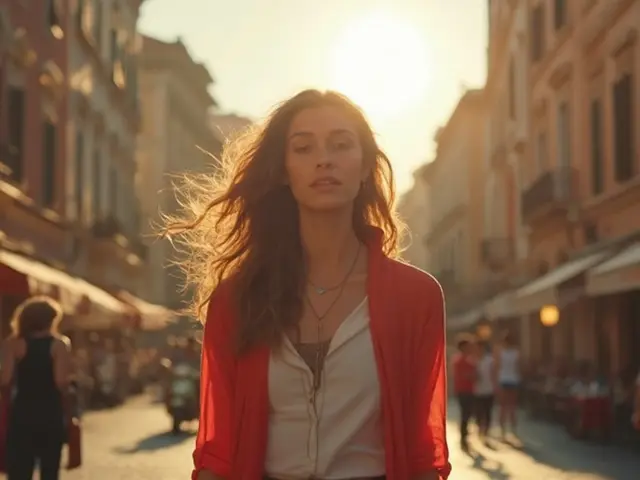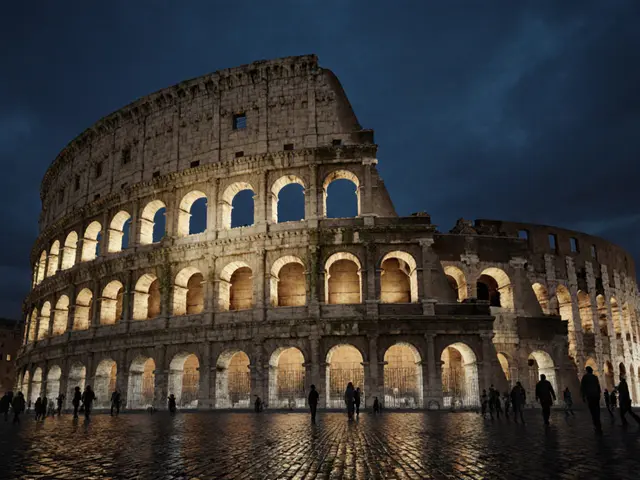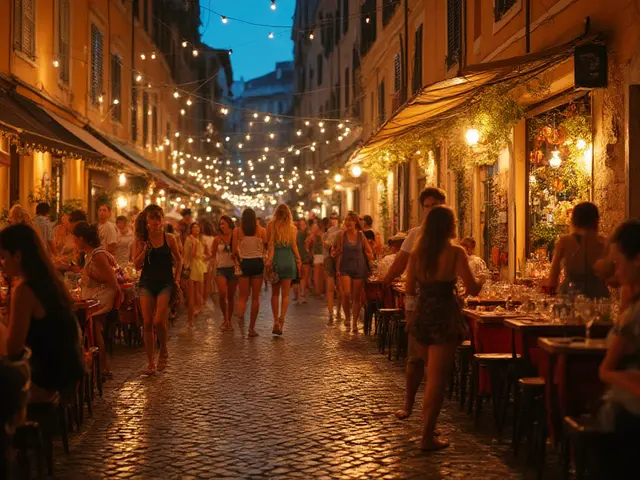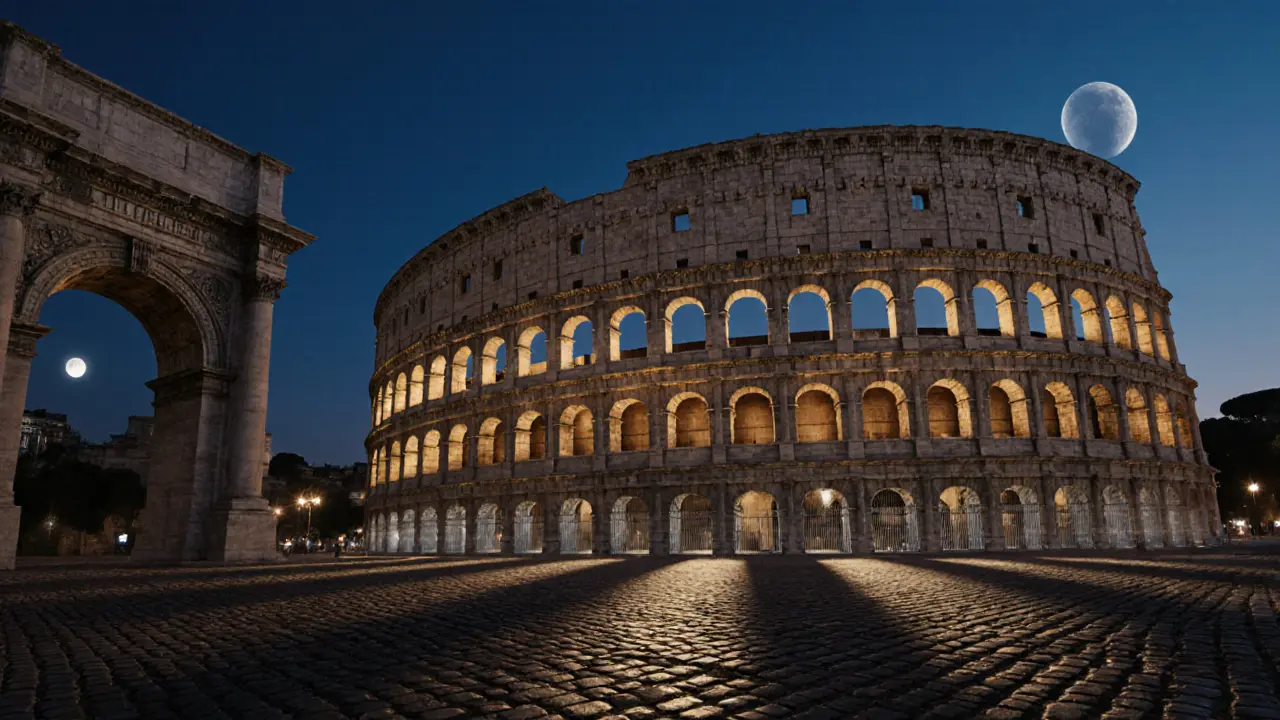
There’s something about Rome after dark that doesn’t show up in guidebooks. The Colosseum doesn’t just stand there-it glows. The Trevi Fountain doesn’t just splash water-it sings in the dark. And the Pantheon? It turns into a cathedral of shadows and starlight. Rome at night isn’t just a different time of day. It’s a different city.
The Colosseum After Sunset
Most tourists leave the Colosseum by 6 PM. That’s their loss. At 8 PM, the floodlights turn on and the ancient stone turns amber. The arches don’t just light up-they come alive. You can walk around the perimeter for free, and if you stand just south of the Arch of Constantine, you’ll see the entire structure lit from within, casting long shadows across the cobblestones. No crowds. No noise. Just the echo of gladiators long gone.
Photographers know this spot. They bring tripods, set up at 7:30, and wait for the perfect moment when the moon rises just behind the outer ring. The contrast between the warm stone and the cool blue sky is unreal. You don’t need a fancy camera. Even your phone will capture something magical if you use Night Mode and steady your hands on a wall.
Trevi Fountain: Not Just a Postcard
The Trevi Fountain is packed during the day. At night, it’s a different kind of chaos-quiet, dreamy, and hypnotic. The water doesn’t just flow. It pulses. The statues of Oceanus, Neptune, and the Tritons seem to move in the flickering light. People still toss coins, but the ritual feels more personal now. Less like a tourist checklist, more like a whispered wish.
There’s a bench just across the street, under the arched entrance of Palazzo Poli. Sit there. Watch the reflections dance on the water. Listen to the sound of the falls. It’s louder at night, clearer. The fountain isn’t just a monument. It’s a living thing, breathing in the cool Roman air.
Pro tip: Go on a weekday. Sunday nights are crowded with locals celebrating the end of the weekend. Tuesday and Wednesday are quietest. You’ll have the front row to yourself.
Castel Sant’Angelo and the Tiber River
Walk along the Tiber River after dark and you’ll see why Romans call it the city’s silver ribbon. The water reflects the lights of the bridges-Ponte Sant’Angelo, Ponte Vittorio, Ponte Regina Margherita-like strings of pearls. Castel Sant’Angelo, once a mausoleum, then a fortress, now a museum, towers above the river like a dark sentinel. Its top glows with a soft white light, and the statue of the Archangel Michael stands sentinel, sword raised, as if guarding the whole city.
There’s a narrow path between the castle and the river, lit by old-fashioned gas-style lamps. Walk it slowly. You’ll pass couples holding hands, artists sketching the skyline, and old men feeding pigeons that never seem to sleep. The air smells like wet stone and espresso from a nearby bar. This is Rome’s quiet heart.
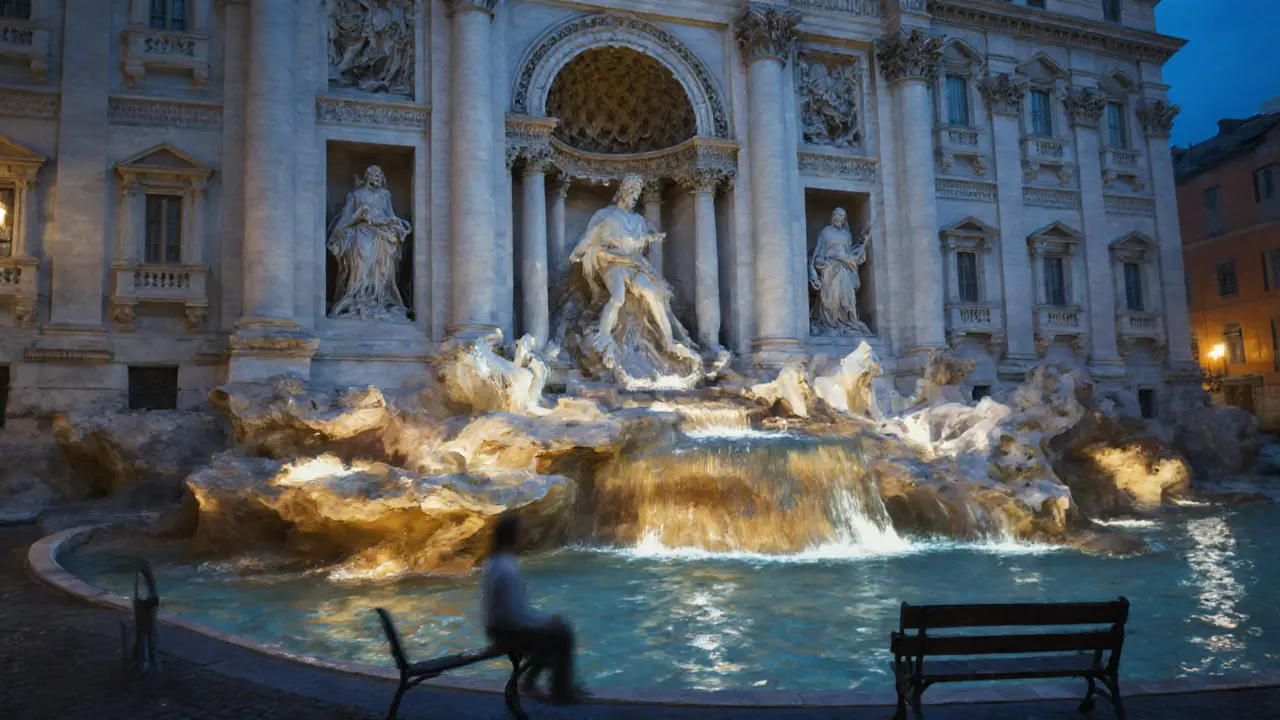
Piazza Navona: Lights, Shadows, and Street Music
By day, Piazza Navona is a circus of street performers and ice cream vendors. By night, it’s a stage. The fountains-Fontana dei Quattro Fiumi, Fontana del Moro-come alive with underwater LEDs. The water dances in rhythm with the music. A violinist plays Vivaldi. A painter captures the scene on canvas. A group of teenagers laughs under the arches, their voices bouncing off the Baroque buildings.
There’s no better place to sip a glass of local wine and just watch. The light from the buildings paints the cobblestones gold. The shadows stretch long. The whole square feels like a painting you can walk into. Skip the overpriced cafés. Head to La Palma on the east side. Their Aperol Spritz is perfect, the terrace is quiet, and the view of the fountain is unobstructed.
The Janiculum Hill: Rome’s Best Panoramic View
If you want to see all of Rome at once, go to the Janiculum Hill. It’s not on the main tourist path. Most people don’t even know it’s there. But locals do. At 9 PM, the hill is quiet. You can sit on the stone wall near the Fontana dell’Acqua Paola and look down on the city like a god.
The dome of St. Peter’s Basilica glows like a pearl. The Vatican obelisk stands tall and dark. The lights of Trastevere twinkle like fireflies. The Tiber snakes through the city like a ribbon of silver. You can see the entire historic center, from the Capitoline to the Appian Way.
Bring a jacket. It’s colder up here. And don’t leave before 10 PM. That’s when the city’s lights fully turn on and the sky turns deep violet. It’s the only place in Rome where you can feel the weight of 2,000 years of history-and still feel peace.
Trastevere After Midnight
Trastevere is Rome’s soul after dark. It’s not fancy. It’s not polished. It’s real. The narrow alleys are lit by strings of fairy lights and glowing windows. The smell of garlic, basil, and wood-fired pizza hangs in the air. You’ll hear Italian spoken louder here than anywhere else. You’ll see grandmas waving from balconies, teenagers dancing on steps, and old men playing cards under lanterns.
Find Da Enzo al 29-it’s tiny, no reservations, and always packed. But you don’t need to eat. Just stand outside, order a glass of wine from the bar next door, and watch the street come alive. The music drifts from open doors. The laughter echoes. This is where Rome doesn’t perform for tourists. This is where it lives.

When to Go and What to Wear
Best months: April to June, September to October. The weather is mild, the crowds are thinner, and the nights are long enough to linger. July and August are hot and sticky. Winter nights are crisp but beautiful-if you dress right.
Wear comfortable shoes. Cobblestones are unforgiving. A light jacket or scarf is a must, even in summer. The night air drops fast. And don’t carry a big bag. Pickpockets are rare, but they’re still around.
What to Skip
Don’t waste time waiting in line for the Vatican Museums at night. The nighttime tours are overpriced and rushed. The Sistine Chapel looks stunning under lights, but you’ll be shoved through in 15 minutes. Skip it.
Don’t go to the Spanish Steps after 11 PM. The area gets sketchy. Stick to the well-lit streets. Rome is safe, but like any big city, it rewards awareness.
Final Thought: Rome Doesn’t Sleep-It Breathes
Rome at night isn’t about ticking off landmarks. It’s about feeling the city’s rhythm. The way the light hits the dome of St. Peter’s just as the moon rises. The sound of a distant accordion drifting from a hidden courtyard. The quiet hum of a city that never truly rests.
You don’t need to see everything. Just find one spot-your spot-and sit with it. Let the stone, the water, the light, and the silence tell you what you came for.
Is it safe to walk around Rome at night?
Yes, Rome is generally safe at night, especially in tourist areas like the historic center, Trastevere, and around the main landmarks. Stick to well-lit streets, avoid isolated alleys after midnight, and keep an eye on your belongings. Pickpockets are rare but exist-just like in any major city. Avoid flashing valuables and don’t wander into unfamiliar neighborhoods alone.
What’s the best time to visit Rome at night for photos?
The best time for photography is during the blue hour-about 30 minutes after sunset until the city lights fully turn on. That’s usually between 8:15 PM and 9 PM in spring and fall. The sky is still deep blue, the monuments are lit, and there are fewer people. Use a tripod or steady your phone on a wall. Night Mode on modern phones works surprisingly well.
Are there free night views in Rome?
Absolutely. The Colosseum perimeter, Piazza Navona, the Tiber River walk, and Janiculum Hill are all free to visit at night. You don’t need tickets for any of these. The only paid night access is for the Vatican Museums or the Capitoline Hill, and even then, the views from outside are just as good.
Can I see the Vatican at night without a ticket?
You can’t enter St. Peter’s Basilica at night unless you’re attending a service or have a ticket for a special event. But you can walk through St. Peter’s Square anytime. The square is lit beautifully after dark, and the dome looks even more majestic from the outside. The best photo spot is across the Tiber River near Ponte Sant’Angelo.
Where should I eat dinner before exploring Rome at night?
Eat in Trastevere or near Campo de’ Fiori. Both areas have authentic, affordable restaurants open late. Try Da Enzo al 29 in Trastevere for classic Roman dishes like carbonara or cacio e pepe. In Campo de’ Fiori, Flavio al Velavevodetto serves excellent pasta and has a cozy courtyard. Avoid restaurants right on major tourist squares-they’re overpriced and tourist traps.

